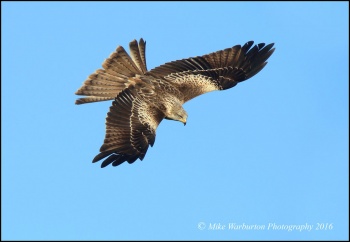- Milvus milvus
Includes Cape Verde Kite
Identification
Length 60–66 cm (23½-26 in), wingspan 145-165 cm (57-65 in), weight 750-1225 gm (1.65-2.7 lb)
- Adult
Plumage is red-brown with darker streaks. Forked tail is rufous. Whitish-grey head and a white patch towards the tip of underwing. Hooked black bill with yellow cere. Yellow legs, eye and skin around the eye.
- Juvenile
Similar to adult, but slightly browner, and paler (particularly the under-tail coverts).
Similar Species
Black Kite which has a much less deeply forked tail that is also shorter: on the sitting bird, primaries reach the end of the tail on Black Kite but reach the base of the fork in the tail on Red Kite. Black Kite has less contrast between dark primary tips and white primary bases. Black Kite shows 6 free primary tips in the extended wing, Red Kite shows five. In flight, the large white wing patches of the Red Kite can appear as "windows", and are often the most obvious diagnostic mark. Compared to Common Buzzard, 50% larger wingspan yet similar body weight, giving it a much lighter, more manoeuvrable flight, floating on even the lightest of breezes when Common Buzzards look clumsy by comparison. Unlike buzzards, frequently twists its tail at up to 70-80° to the plane of the wings.
Distribution
Confined to the Western Palearctic the Red Kite is found as a breeding species in Iberia and discontinuously from France east to Belarus and the Ukraine.
In Britain it has long been reduced to a tiny remnant population in central Wales but in recent years extensive release programmes have led to breeding once again in parts of Scotland and England and in 2000 more than 400 pairs breeding or attempting to breed in the UK, increasing to over 1,200 pairs by 2011. This re-introduction has been very successful in the Chilterns, where they have spread south into Berkshire, and are now (2010) a common sight in the skies over Maidenhead. Some other introductions have been less successful, with those in northeast England and eastern Scotland particularly badly hit by illegal persecution by shooting estates.
Outside Iberia populations in mainland Europe are scattered with isolated pockets in central and eastern France, eastern Belgium, Luxembourg and southern parts of the Netherlands, Denmark and Sweden. The range becomes more continuous from Germany and northern Switzerland east to north Poland and Belarus and south to the northwestern shores of the Black Sea. There is a very isolated resident population in the Caucasus. A few small pockets still survive in Slovakia, Hungary and northern Yugoslavia but it is now very rare in southeast Europe. In the Mediterranean area Red Kites breed on the Balearics, Corsica and Sardinia and on Sicily and in the southern third of Italy.
It is now a very rare bird in North-West Africa where small numbers can still be found in northern Morocco and may possibly still breed in Algeria and Tunisia. Rare and decreasing on the Canary Islands and highly endangered and close to extinction in the Cape Verde Islands.
All island populations of Red Kites are mainly resident with some dispersal, mainly of immatures, as are birds from Iberia, Wales, France and southern Europe. Birds from the north and east are more migratory but some tend to stay in the breeding area through the winter, especially in recent decades. Most winter in southern Europe from Spain to Greece or small numbers cross at Gibraltar to winter in North Africa. Red Kites prefer to cross water by the shortest route and appear in small numbers at the major raptor migration watchpoints. The reintroduction programmes in Britain have been highly successful particularly in the Black Isle of Scotland and the Chiltern Hills of England. A bird from the Scottish reintroduction programme has wandered to Iceland and vagrants have been recorded in the Channel Islands.
Taxonomy
Subspecies
Two subspecies are accepted, one of them recently extinct[1]:
- M. m. milvus:
- Western Palearctic region
- M. m. fasciicauda:
Status of Cape Verde Kite
Birds on the Cape Verde Islands have been considered a subspecies of the Red Kite, M. m. fasciicauda, but it has been suggested that they are hybrids between Red and Black Kites or more recently (Sibley & Monroe, 1996) that they represent a full species. However they are classified, Cape Verde Kites are now extremely rare and none were found during a search in spring 2001. However, later the same year four kites were found on Boavista. The decline of this form is thought in part to be due to the expansion of the Black Kite on the islands. Johnson et al. (2005) found that phylogenetic evidence suggests that Cape Verde Kite specimens collected between 1897 and 1924 belonged to a Red Kite clade that was not restricted to the islands, and that kites collected on the Cape Verde Islands in 2002 were all Black Kites.
Habitat
Favours hilly country with a mixture of mature deciduous woodland and open fields, sometimes near rivers and lakes but less tied to water than the Black Kite.
Behaviour
Breeding
An untidy nest in a tree. Sometimes utilises old Carrion Crow nests.
Diet
Mostly carrion, but will also take rabbits and small birds
Vocalisation
References
- Clements, J. F., T. S. Schulenberg, M. J. Iliff, D. Roberson, T. A. Fredericks, B. L. Sullivan, and C. L. Wood. 2017. The eBird/Clements checklist of birds of the world: v2017, with updates to August 2017. Downloaded from http://www.birds.cornell.edu/clementschecklist/download/
- Johnson, J.A., Watson, R.T. and Mindell, D.P. (2005) Prioritizing species conservation: does the Cape Verde Kite exist?. Proc. R. Soc. Lond. Ser. B 272: 1365-1371.
- Collins Pocket Guide to British Birds 1966
- Collins Field Guide 5th Edition
- Birdforum thread discussing id of Red vs Black Kite
Recommended Citation
- BirdForum Opus contributors. (2025) Red Kite. In: BirdForum, the forum for wild birds and birding. Retrieved 9 May 2025 from https://www.birdforum.net/opus/Red_Kite
External Links
GSearch checked for 2020 platform.1






